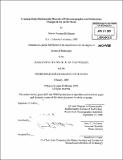| dc.contributor.advisor | Jerry F. McManus. | en_US |
| dc.contributor.author | Hoffmann, Sharon Susanna | en_US |
| dc.contributor.other | Woods Hole Oceanographic Institution. | en_US |
| dc.date.accessioned | 2010-05-27T19:46:46Z | |
| dc.date.available | 2010-05-27T19:46:46Z | |
| dc.date.copyright | 2009 | en_US |
| dc.date.issued | 2009 | en_US |
| dc.identifier.uri | http://hdl.handle.net/1721.1/55329 | |
| dc.description | Thesis (Ph. D.)--Joint Program in Oceanography (Massachusetts Institute of Technology, Dept. of Earth, Atmospheric, and Planetary Sciences; and the Woods Hole Oceanographic Institution), 2009. | en_US |
| dc.description | Includes bibliographical references. | en_US |
| dc.description.abstract | The radionuclides ²³¹Pa and ²³⁰Th, produced in the water column and removed from the ocean by particle scavenging and burial in sediments, offer a means for paleoceanographers to examine past dynamics of both water column and sedimentary processes. I show for the first time that a state of balance exists between ²³⁰Th production and burial in the Central Arctic basins, based on measured sedimentary ²³⁰Th, inventories in box cores, establishing this nuclide's utility as a paleoceanographic indicator of sedimentary processes and as a normalization tool. I present the first ²³⁰Th-normalized particle fluxes calculated for the central Arctic: vertical particle fluxes were extremely low during the late glacial, rose during the deglaciation due to particle inputs from shelf inundation, increased productivity and ice-rafted debris, and fell again following the establishment of interglacial conditions. A major event of lateral sediment redistribution, inferred from surplus ²³⁰Th, inventories, occurred in the Makarov Basin during the deglaciation and may have been due to destabilization of slope and shelf sediments as sea level rose. I present the first high-resolution, radiocarbon-dated downcore records of sedimentary ²³¹Pa/²³⁰Th from the Arctic Ocean. Low ratios indicate that ²³¹Pa was exported from all sites during the late glacial period, with export decreasing during the deglaciation and Holocene. 231Pa/²³⁰Th measurements in cores from three continental slope sites show no evidence for a ²³¹Pa sink related to boundary scavenging on the continental slopes. Holocene ²³¹Pa/²³⁰Th ratios show a very significant variation by depth, with strong export of ²³¹Pa at deep sites but little or no export at shallow sites, a result which echoes findings for the South Atlantic and the Pacific. | en_US |
| dc.description.abstract | (cont.) The Arctic thus appears fundamentally similar to other ocean basins in its ²³¹Pa and ²³⁰Th dynamics, despite its peculiar qualities of sea ice cover, low particle flux, and relatively isolated deep waters. | en_US |
| dc.description.statementofresponsibility | by Sharon Susanna Hoffmann. | en_US |
| dc.format.extent | 207, [1] p., 4 leaves | en_US |
| dc.language.iso | eng | en_US |
| dc.publisher | Massachusetts Institute of Technology | en_US |
| dc.rights | M.I.T. theses are protected by
copyright. They may be viewed from this source for any purpose, but
reproduction or distribution in any format is prohibited without written
permission. See provided URL for inquiries about permission. | en_US |
| dc.rights.uri | http://dspace.mit.edu/handle/1721.1/7582 | en_US |
| dc.subject | Earth, Atmospheric, and Planetary Sciences. | en_US |
| dc.subject | Joint Program in Oceanography. | en_US |
| dc.subject | Woods Hole Oceanographic Institution. | en_US |
| dc.title | Uranium-series radionuclide records of paleoceanographic and sedimentary changes in the Arctic Ocean | en_US |
| dc.type | Thesis | en_US |
| dc.description.degree | Ph.D. | en_US |
| dc.contributor.department | Joint Program in Oceanography | en_US |
| dc.contributor.department | Woods Hole Oceanographic Institution | en_US |
| dc.contributor.department | Massachusetts Institute of Technology. Department of Earth, Atmospheric, and Planetary Sciences | |
| dc.identifier.oclc | 430034794 | en_US |
